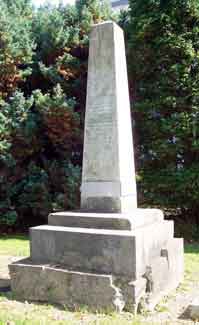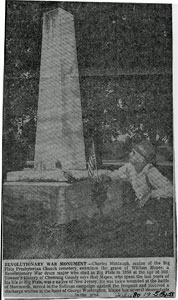Many notable citizens of Big Flats are buried in Miller Cemetery, as evidenced in this excerpt from History of the First Presbyterian Church of Big Flats, New York:
John B. Sexton wrote an article about the early history of the church in the Blossburg Advertiser in 1904. In it he wrote as follows. “While the church has been reseated …. we could locate the pews of the largest portion of its congregation of years ago, the Gardiners, the Reynolds, the McNultys, the Owens, the Miniers, the Noyes, the Farrs, the Hammonds, the Fullers, the Pounds, the families of Judson M. Park, Henry Lovell, Samuel K. Wolcott, David Bonham, William A. Tuttle, Patrick Haggerty, James Hughson, Nathan and Reuben. Mundy, John W. Hughson, the Winters, Winans and Sexton families, John F. Smith and his sister, Perry Burdick, Amasa Burt, John W., Durham and many others…. The larger number of…. these old occupants…. are now sleeping…. in the city of the dead…. that adjoins this old church edifice.”

Drum Major in … Continential
Line was present at the
surrender of Cornwallis and
received an honorable
discharge written in the hand
of Washington d. April 1,
1852 in the 103rd year of his
age”
Click for larger inscription
According to RootsWeb and JoyceTice.com there are also at least eight Veterans of the American Revolution buried in Miller Cemetery. They are:
- Jonathan Boyer, Soldier
- George Gardner, Soldier
- John William Harper, Soldier
- William Mapes, Drummer
- Hugh Miller, Soldier
- David Reynolds, PVT
- Joel Rowley, Corporal
- John Williams, Soldier

examines the grave of
William Mapes in 1954
Click for larger image
Of these we probably have the most information on Drum Major William Mapes, owing to the well preserved detail on his obelisk (right). Still more information on Miller Cemetery and William Mapes is available through Tri-Counties Genealogy & History by Joyce M. Tice. Shortly after enlisting, William Mapes was at battle of Monmouth in 1778 where he received bayonet and bullet wounds, followed by his participation in the Sullivan campaign in 1779 (where he most likely saw the Chemung Valley for the first time), and was present at the surrender of Cornwallis at Yorktown in 1781. Tice offers much more information than this, and in wonderful prose. It’s a particularly interesting local story because Mapes did not come to Big Flats until he was eighty years old — fifty years after first seeing this region. He so endeared himself to this community in the twenty years that followed that the citizens of Big Flats pitched in to provide this wonderful obelisk upon his death.
New information will be added to this page as it becomes available. Do you have any tidbits on who’s who in Miller Cemetery? If so, please let us know!



